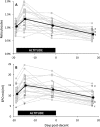Year-to-year variability in haemoglobin mass response to two altitude training camps
- PMID: 24282208
- PMCID: PMC3903153
- DOI: 10.1136/bjsports-2013-092744
Year-to-year variability in haemoglobin mass response to two altitude training camps
Abstract
Aim: To quantify the year-to-year variability of altitude-induced changes in haemoglobin mass (Hb(mass)) in elite team-sport athletes.
Methods: 12 Australian-Footballers completed a 19-day (ALT1) and 18-day (ALT2) moderate altitude (∼2100 m), training camp separated by 12 months. An additional 20 participants completed only one of the two training camps (ALT1 additional n=9, ALT2 additional n=11). Total Hb(mass) was assessed using carbon monoxide rebreathing before (PRE), after (POST₁) and 4 weeks after each camp. The typical error of Hb(mass) for the pooled data of all 32 participants was 2.6%. A contemporary statistics analysis was used with the smallest worthwhile change set to 2% for Hb(mass).
Results: POST₁ Hb(mass) was very likely increased in ALT1 (3.6 ± 1.6%, n=19; mean ± ∼90 CL) as well as ALT2 (4.4 ± 1.3%, n=23) with an individual responsiveness of 1.3% and 2.2%, respectively. There was a small correlation between ALT1 and ALT2 (R=0.21, p=0.59) for a change in Hb(mass), but a moderately inverse relationship between the change in Hb(mass) and initial relative Hb(mass) (g/kg (R=-0.51, p=0.04)).
Conclusions: Two preseason moderate altitude camps 1 year apart yielded a similar (4%) mean increase in Hb(mass) of elite footballers, with an individual responsiveness of approximately half the group mean effect, indicating that most players gained benefit. Nevertheless, the same individuals generally did not change their Hb(mass) consistently from year to year. Thus, a 'responder' or 'non-responder' to altitude for Hb(mass) does not appear to be a fixed trait.
Keywords: Altitude; Elite performance; Exercise; Physiology.
Figures






Similar articles
-
Physiological and performance responses to a preseason altitude-training camp in elite team-sport athletes.Int J Sports Physiol Perform. 2013 Jul;8(4):391-9. doi: 10.1123/ijspp.8.4.391. Epub 2012 Nov 19. Int J Sports Physiol Perform. 2013. PMID: 23170749 Clinical Trial.
-
Variability in hemoglobin mass response to altitude training camps.Scand J Med Sci Sports. 2021 Jan;31(1):44-51. doi: 10.1111/sms.13804. Epub 2020 Sep 9. Scand J Med Sci Sports. 2021. PMID: 32783231
-
Adding heat to the live-high train-low altitude model: a practical insight from professional football.Br J Sports Med. 2013 Dec;47 Suppl 1(Suppl 1):i59-69. doi: 10.1136/bjsports-2013-092559. Br J Sports Med. 2013. PMID: 24282209 Free PMC article. Clinical Trial.
-
Relationship between changes in haemoglobin mass and maximal oxygen uptake after hypoxic exposure.Br J Sports Med. 2013 Dec;47 Suppl 1(Suppl 1):i26-30. doi: 10.1136/bjsports-2013-092841. Br J Sports Med. 2013. PMID: 24282203 Free PMC article. Review.
-
Hemoglobin Mass and Aerobic Performance at Moderate Altitude in Elite Athletes.Adv Exp Med Biol. 2016;903:357-74. doi: 10.1007/978-1-4899-7678-9_24. Adv Exp Med Biol. 2016. PMID: 27343108 Review.
Cited by
-
Applied Sport Science of Australian Football: A Systematic Review.Sports Med. 2018 Jul;48(7):1673-1694. doi: 10.1007/s40279-018-0919-z. Sports Med. 2018. PMID: 29633084
-
Primum non nocere; It's time to consider altitude training as the medical intervention it actually is!Front Psychol. 2022 Dec 13;13:1028294. doi: 10.3389/fpsyg.2022.1028294. eCollection 2022. Front Psychol. 2022. PMID: 36582343 Free PMC article. Review.
-
Position statement--altitude training for improving team-sport players' performance: current knowledge and unresolved issues.Br J Sports Med. 2013 Dec;47 Suppl 1(Suppl 1):i8-16. doi: 10.1136/bjsports-2013-093109. Br J Sports Med. 2013. PMID: 24282213 Free PMC article.
-
The Effects of Altitude Training on Erythropoietic Response and Hematological Variables in Adult Athletes: A Narrative Review.Front Physiol. 2018 Apr 11;9:375. doi: 10.3389/fphys.2018.00375. eCollection 2018. Front Physiol. 2018. PMID: 29695978 Free PMC article. Review.
-
High-level performances following low altitude training and tapering in warm environments in elite racewalkers.Eur J Sport Sci. 2024 Aug;24(8):1120-1129. doi: 10.1002/ejsc.12161. Epub 2024 Jul 11. Eur J Sport Sci. 2024. PMID: 38992976 Free PMC article.
References
-
- Stray-Gundersen J, Chapman RF, Levine BD. ‘Living high-training low’ altitude training improves sea level performance in male and female elite runners. J Appl Physiol 2001;91:1113–20 - PubMed
-
- Robertson EY, Saunders PU, Pyne DB, et al. Reproducibility of performance changes to simulated live high/train low altitude. Med Sci Sports Exerc 2010;42:394–401 - PubMed
-
- Chapman RF, Stray-Gundersen J, Levine BD. Individual variation in response to altitude training. J Appl Physiol 1998;85:1448–56 - PubMed
-
- Wachsmuth NB, Volzke C, Prommer N, et al. The effects of classic altitude training on hemoglobin mass in swimmers. Eur J Appl Physiol 2013;113:1199–211 - PubMed
MeSH terms
Substances
LinkOut - more resources
Full Text Sources
Other Literature Sources
